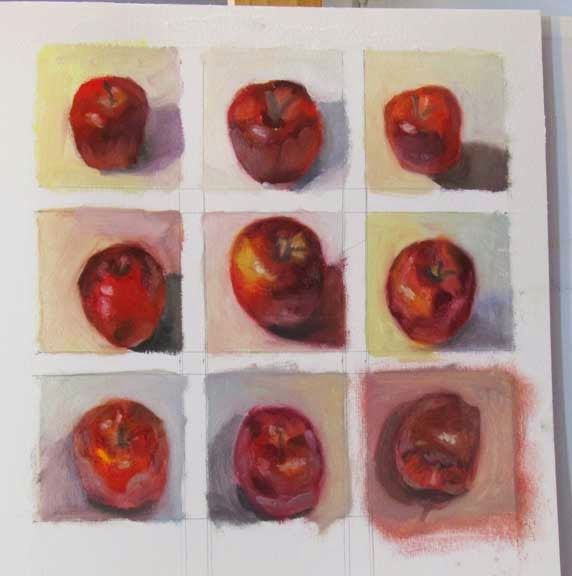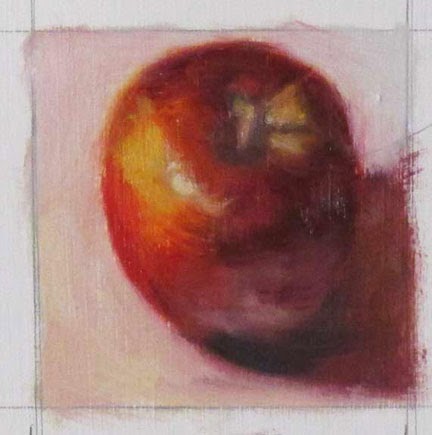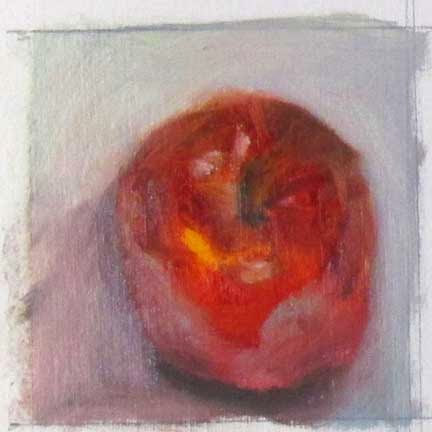~ Lucian Freud
 |
| My Apple Phase (although a lot of them could get stand-in parts as red peppers.) |
As many of you know, I switched from painting with acrylics to oils this summer and that I am over the moon in love with my new medium, but in these first giddy months of our relationship we're still learning a lot about each other. That's why I ordered Carol Marine's new book Daily Painting. (I should note that much of this book could apply to any medium, but I was partially motivated to get the book due to the author's medium being oil.) It arrived on Tuesday, and I spent the rest of the afternoon totally engrossed in it. Wednesday I had some other obligations so further reading had to wait, but on Thursday I woke up early in anticipation of being able to devote the day to Daily Painting.
I decided to do an exercise in the book called Ten Minute Apples, in which you paint an apple 8 times*, but you only have 10 minutes to do each painting. The idea is to concentrate on values and form, and not fuss over every little detail. I had a shiny apple (and I mean really shiny. How much wax did they coat it with???) ready to go. I set up my palette and my lighting, had some energetic tunes playing** and I dove into the exercise. Then some interesting things started to happen.
What many of you may not know is that my undergraduate degree is in Psychology. I wanted to get a BFA, but that was not considered "practical" so I went with my other interest - why our brains do what they do. (Don't get me started on how unpractical a BA in Psychology is, but it was more acceptable than a BFA, so I did it and just took as many fine art electives as I could and spent the next 20 years feeling like an artist wannabe. Thank goodness for getting older and not caring so much about what other people think anymore. But I digress.) So I noted my mental state and what was happening on my canvas during the exercise with interest.
After about the third apple painting, part of my brain started screaming with boredom. "It's an apple. I get it already. Do we have to paint 6 more?" Then a funny thing happened. As I continued with the exercise that part of my brain checked out. And when it checked out, suddenly I was painting much more intuitively, my apples started to look more apple-like in a painterly way, I was making interesting color choices and figured out problems that had been baffling me on the previous 3 paintings and I wasn't rushing to finish in 10 minutes. Then on the 9th painting that part of my brain checked back in. I guess it had been secretly keeping track and knew this was the last painting. Sure enough, that painting was one of my weaker ones and I didn't finish before the timer went off. Fascinating...
 |
| Apple #5 - or the apple that said "apple" |
 | |
| Apple #7 - or the apple in which I finally figured out that the waxy sheen on the bottom half of the apple was light blue |
Those of you who are familiar with Betty Edwards' book Drawing on the Right Side of the Brain might find this scenario reminiscent of her descriptions about the shift from left brain to right brain. It sure reminded me of that. Whether or not that's truly what was happening in my brain I don't know, but I found the Ten Minute Apples exercise very useful. I feel more confident in my mixing and handling of oil paints. And although the stated purpose of this particular exercise itself did not include tapping into a more creative way of painting, the take-home message I got from the exercise (and from the whole book) is that a lot of the roadblocks I run into with painting can be solved by me just getting out of my own way and allowing myself to experiment, explore, and play without worrying about the results. I can definitely see myself doing this exercise over and over, although that one part of my brain may get pretty sick of apples.
*My canvas divided up evenly for 9 paintings, so I did an extra one.
**I am rather partial to Rodrigo y Gabriela in the studio. Upbeat classical guitar with no lyrics to distract me.

2 comments:
This was such a great post, it gave me a real shot of enthusiasm about art that has been lacking for a long time.
Years ago I came across an article in, Artists Magazine that showed the techniques of the old masters. I threw out my acrylics and jumped into oil paints for years. One day it occured to me that I could achieve the same results in acrylics much faster, without all the smells of oils.
Now that I am back using acrylics, I have fallen into a rut again. Oh well.
Hi John,
Thanks for your comment. I'm glad my post gave you a shot of enthusiasm. Knowing my posts are helpful gives me a shot of enthusiasm!
I'm sorry to hear that you have fallen into a rut again. I was definitely in a rut with my wildlife painting when I first tried still life, and then more recently figurative painting and landscapes. It is a joy (most of the time) to paint again. Is there some other subject, or even a completely different medium (like printmaking) that you could try, to see if you can get your joy back?
Also, if you liked oils except for the smell, I urge you to do some research on turpentine alternatives. Turpenoid has no odor to speak of, and some people swear by Gamsol. Other people don't use solvents at all, but clean their brushes with linseed oil, or use walnut oil as a medium with their paints in place of turpentine.
Best of luck with it all, John. Being in a rut is a frustrating, depressing thing and I hope you find your way out soon!
Post a Comment